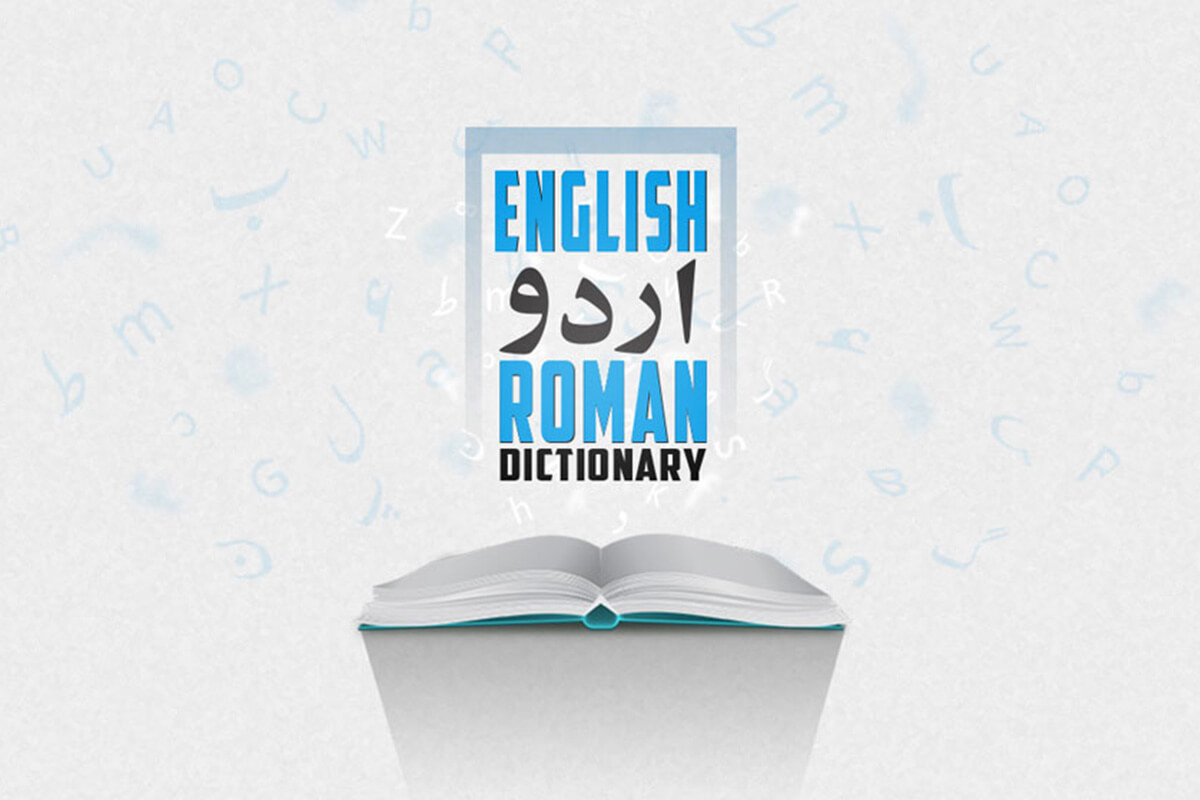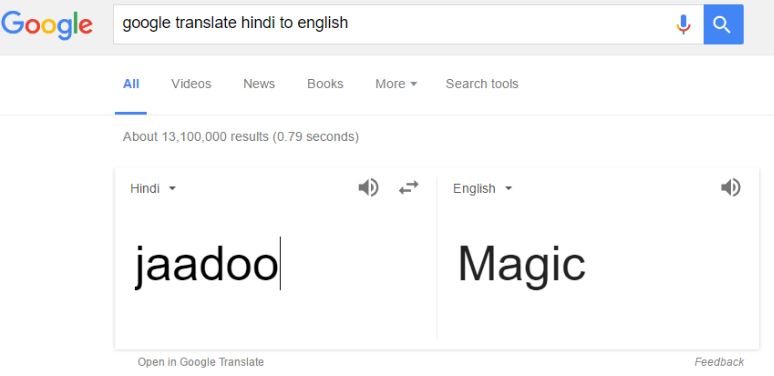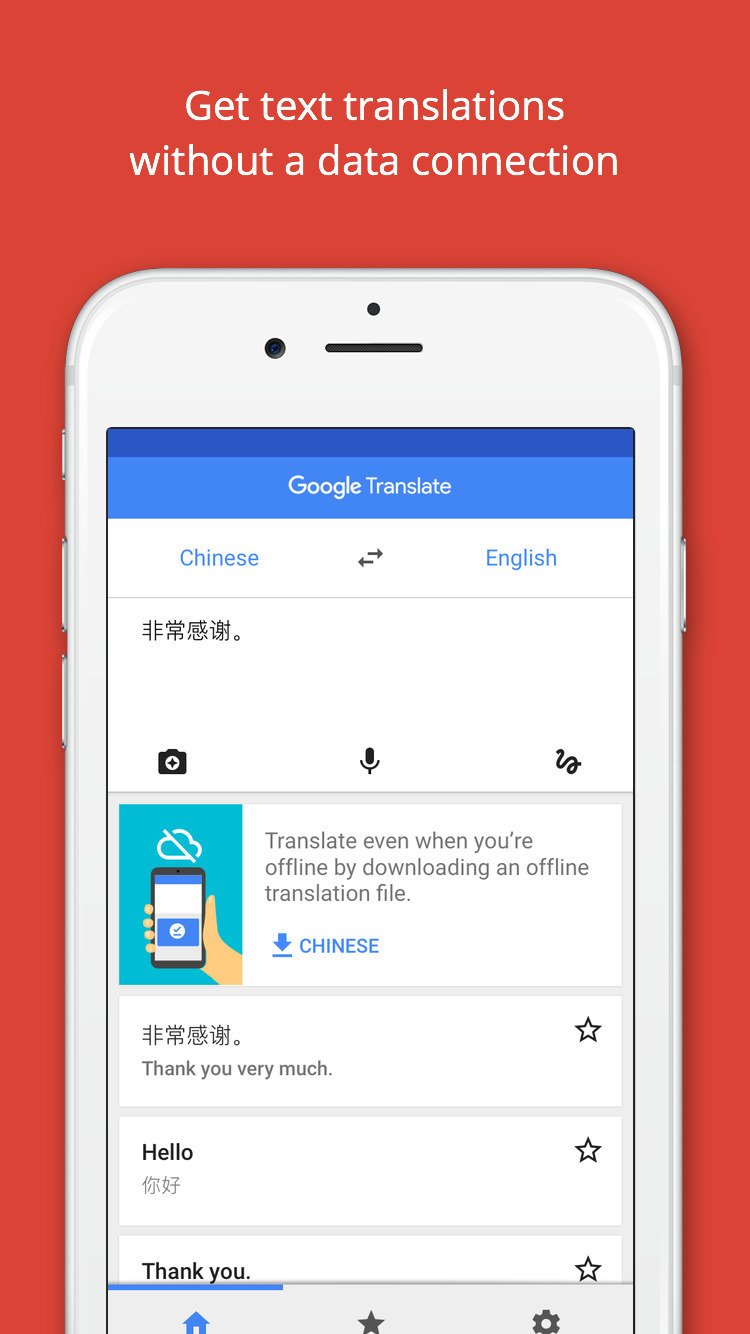Urdu English Translator comes with useful features to make word searching quicker compared from using a bulky dictionary. Users can either type in English or Urdu through the app's main interface. Users then select the language opposite from what they have entered earlier and the final output is displayed at the bottom. They can highlight and copy the translated word and press the app's Copy button.
The newly translated word is saved in the device's temporary clipboard. If they wish to remove the saved word from the app's interface, they can quickly erase it with the Clear button. The History button tracks back what the users entered for the past few session.
This will help users remember the words they were looking for. The app has an additional feature to read and speak translated text, just make sure the English Audio and Urdu Audio features are already installed in the device. This audio feature is useful for conversing with anyone in real time, at the same time know the proper pronunciation of the translated word. The app also runs offline so that users don't have to connect online and search the right word.
In this way, it serves as a dictionary on the go if an online connection is impossible geographically. Since the app runs on most devices, any newly found words are shareable to social media platforms. Users can simply paste the words on social media sites like Facebook or Twitter so that their personal contacts will discover their attempt to expand their vocabulary.
Travelers and students will benefit from the app because it provides everything they needed when it comes to communicating between English and Urdu. The app is also created as a learning tool for everyone's convenience. All of these benefits eradicate the problem of language barrier despite the app only providing simple word translation. People will recognize the efforts of users attempting to connect with them by using common vocabulary in English or Urdu. It comes with a camera translation feature, which works for major Asian characters . As such, it's one of the best translation apps in the Asian market.
It can translate text messages, voice, as well as conversational translations. It is also capable of copying and sharing translated texts through email, SMS, pdf file, and social media. When you translate speech, the voice output can be set to male or female, and can be slowed down for easier emulation. This is a great feature for those who want to learn how to speak a new language.
For learning on-the-go, install this app on your apple watch! This feature-rich translator could use an offline mode, though, just like most other major translator apps and also features alternative translations. Due to differences between languages in investment, research, and the extent of digital resources, the accuracy of Google Translate varies greatly among languages.
No languages indigenous to Australia or the Americas are included within Google Translate. A 2010 analysis indicated that French to English translation is relatively accurate, and 2011 and 2012 analyses showed that Italian to English translation is relatively accurate as well. However, if the source text is shorter, rule-based machine translations often perform better; this effect is particularly evident in Chinese to English translations. While edits of translations may be submitted, in Chinese specifically one cannot edit sentences as a whole.
Instead, one must edit sometimes arbitrary sets of characters, leading to incorrect edits. Formerly one would use Google Translate to make a draft and then use a dictionary and common sense to correct the numerous mistakes. As of early 2018 Translate is sufficiently accurate to make the Russian Wikipedia accessible to those who can read English. The quality of Translate can be checked by adding it as an extension to Chrome or Firefox and applying it to the left language links of any Wikipedia article.
One can translate from a book by using a scanner and an OCR like Google Drive, but this takes about five minutes per page. Google Translate produces approximations across languages of multiple forms of text and media, including text, speech, websites, or text on display in still or live video images. For some languages, Google Translate can synthesize speech from text, and in certain pairs it is possible to highlight specific corresponding words and phrases between the source and target text. Results are sometimes shown with dictional information below the translation box, but it is not a dictionary and has been shown to invent translations in all languages for words it does not recognize.
If "Detect language" is selected, text in an unknown language can be automatically identified. In the web interface, users can suggest alternate translations, such as for technical terms, or correct mistakes. These suggestions may be included in future updates to the translation process. If a user enters a URL in the source text, Google Translate will produce a hyperlink to a machine translation of the website. Users can save translation proposals in a "phrasebook" for later use.
For some languages, text can be entered via an on-screen keyboard, through handwriting recognition, or speech recognition. It is possible to enter searches in a source language that are first translated to a destination language allowing one to browse and interpret results from the selected destination language in the source language. That includes full offline support, auto suggestions, pronunciations, voice search, synonyms, antonyms, and word games for memorization practice. You simply find the one with the language you want and it translates between that language and English.
We wish we could pay to remove the ads, but it's a relatively minor complaint. Google Translate is probably the very best translation app on mobile. It supports over 100 languages online and over 50 languages offline .
It also translates stuff with your camera like menus or street signs. The app also supports handwriting, voice input, and typing input . Finally, it can even translate a full conversation in real time if needed. Aside from the occasional goof or bug, there isn't much wrong with it. Google Translate has one of the most advanced if not the most advanced free translation software. The great tech is what makes Google Translate one of the most popular translation apps in the world as it can be used for formal and informal speech.
It is the result of years of development and the most recent relevant technological advancements. These manifest in the extensive range of features the app offers. It can translate text in more than 100 languages and is even capable of offline translations in multiple languages . Additionally, it can translate text and numbers as taken by a device's camera or by analyzing a photo or image fed into the app .
They help people communicated without a human translator or spending months learning a language. Most use cases involve translating something you see on social media, although most social media sites have built-in translations now. Generally speaking, most translation app use are for infrequent travelers, students looking to study a new language, and translating a menu or something in a restaurant. We have a whole list of outstanding translation apps below. Most use cases are solved by Google Translate, Microsoft Translate, or Reverso Dictionary. Assistant will speak its translations aloud, but you can also opt to use the keyboard (and show the person your phone's screen) if you're in a quiet environment.
The system will automatically choose the language you want to translate based on your location, though you can configure this manually too. Assistant is also powerful enough to offer up smart replies after translations, which are short phrases you can tap that the AI-powered software thinks might be natural follow-ups. If you need to translate text, Google Lens, which is already baked into Assistant on Android phones, can currently do this in real time using your phone's camera. Current statusActiveGoogle Translate is a multilingual neural machine translation service developed by Google to translate text, documents and websites from one language into another. It offers a website interface, a mobile app for Android and iOS, and an API that helps developers build browser extensions and software applications. As of January 2022, Google Translate supports 109 languages at various levels and as of April 2016, claimed over 500 million total users, with more than 100 billion words translated daily.
Hi Translate app is one of fine app for real time translation. The app comes with extra ordinary features such as Voice translation, Text translation, Real-time translation and offline translation as well. The thing about this app is you can capture the images of which you want to translate in your preferred language through your phones camera. Which means you have to just set you phone camera on the text image and it will give you translation with in a few seconds.
This unique feature of this app make it different from others. Apart from you can translate your text upto 100 languages. Which allows you to use it with any app to read/write in almost any language. Google Translate is an excellent tool to translate random text, phrases, and words from one language to another.
With plenty of features and support for over 90 languages, Google Translate is one of the most popular and useful translators online. While using the Android or iOS versions, you can translate words from audio, SMS, images, and whiteboards, making it a full-fledged pocket translator at your disposal. Additionally, the app listens to audio for making translations in select languages. Naver Papago is a translation app by Naver, a very popular search engine in South Korea.
It's not all that different from Google Search and Google Translate. Anyway, Naver Papago supports translation between 13 languages. You can translate text, images, and voice with real-time translations. Additionally, it 100% works offline and it can even recognize things like handwriting and websites. It's not quite as broad as something like Google Translate or Microsoft Translate.
Some seem to have trouble with the website translation feature so beware of that. BK Translate is a developer on Google Play with a variety of translation apps. They have dozens of languages, including popular ones like Spanish, Arabic, German, Indonesian, French, and many others. It translates between whatever language it supports and English. Additionally, it works with both words and full sentences. Google initially envisioned Interpreter Mode as a handy tool you'd use at hotel concierge desks with a Nest Home Mini sitting next to the service bell.
The tech's migration to phones makes it possible for anyone to take the feature out and about. Unfortunately, since the translation currently takes place in the cloud, it only works if you're online. That differs from the Google Translate app, which lets you download a language so you can use the service offline to translate typed words and phrases—handy when you might be using a local SIM with limited data. Google told WIRED it's exploring support for offline translations with Assistant's Interpreter Mode. Although Google deployed a new system called neural machine translation for better quality translation, there are languages that still use the traditional translation method called statistical machine translation.
It is a rule-based translation method that utilizes predictive algorithms to guess ways to translate texts in foreign languages. It aims to translate whole phrases rather than single words then gather overlapping phrases for translation. Moreover, it also analyzes bilingual text corpora to generate statistical model that translates texts from one language to another. Launched in April 2006 as a statistical machine translation service, it used United Nations and European Parliament documents and transcripts to gather linguistic data.
During a translation, it looks for patterns in millions of documents to help decide which words to choose and how to arrange them in the target language. Its accuracy, which has been criticized and ridiculed on several occasions, has been measured to vary greatly across languages. Originally only enabled for a few languages in 2016, GNMT is now used in all 109 languages in the Google Translate roster as of January 2022. Attach to a Wi-Fi network as well as download the google translate app from the play shop as well as install it. The really very first time you opened the app, It asked to download and install the language data.
That will certainly download the language onto your device and also lets you translate words without an internet connection. Another translation app heavyweight, Microsoft Translator, is one of the many free translation apps capable to translate text, voice, conversation, and image translations. It can perform both online and offline translations in more than 60 languages. Just like Google Translate, though, you need to download language packs to enable offline use. You'll also notice three options at the bottom of the text box. They allow you to switch to the camera for real-time translations or to take photos to upload, open up conversation mode, or turn on voice to speak your required phrase or word instead of typing it.
To translate handwritten text, just click the pen icon on the right-hand side of the screen to open the handwriting screen. We have developed a UX-friendly, easy to use free translations app, available for iOS and Android on your phone, and any desktop. However, consider that machine-generated translations, even with AI and neural networks involved, are not guaranteed to be fully accurate. They can't be used for business or when submitting translated media to government offices or academic institutions. That's why the ranking of apps here puts emphasis on the superiority of human translations, hence apps that connect users to professional human translators rank high in the list above.
In addition to the default English language, the UI of this app is translated to an additional 52 languages. The service has built-in support for real-time translation of over 100 languages and can offer automatic language detection of selected text. Now on Tap, which can translate certain languages to and from your native tongue, now supports any mobile app or screen on your Android device, Google said in a blog post published Wednesday.
On webpages written in foreign languages, the feature offers to translate the text into your native language. In apps and other screens, just hold down the Home button and tap the "Translate this screen" card, and the text gets translated. Google has crowdsourcing features for volunteers to be a part of its "Translate Community", intended to help improve Google Translate's accuracy. In August 2016, a Google Crowdsource app was released for Android users, in which translation tasks are offered. First, Google will show a phrase that one should type in the translated version. Second, Google will show a proposed translation for a user to agree, disagree, or skip.
Third, users can suggest translations for phrases where they think they can improve on Google's results. In January 2015, the apps gained the ability to propose translations of physical signs in real time using the device's camera, as a result of Google's acquisition of the Word Lens app. In May 2014, Google acquired Word Lens to improve the quality of visual and voice translation. It is able to scan text or a picture using the device and have it translated instantly. Moreover, the system automatically identifies foreign languages and translates speech without requiring individuals to tap the microphone button whenever speech translation is needed. Microsoft Translator app is comes with 60 language translation options which is less from other but it is completely free to use for both Android and iOS users.




























